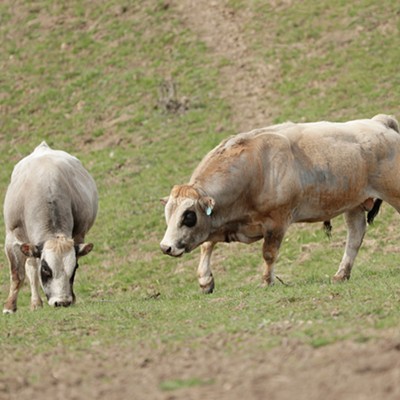In 2008, Mexican authorities rejected a shipment of U.S. beef because the meat exceeded Mexico's regulatory tolerance for copper. The rejected meat was returned to the United States, where it was sold and consumed, because the U.S. has no regulatory threshold for copper in meat.
Events like this are why the food safety arm of the U.S. Department of Agriculture, known as the Food Safety and Inspection Service, is under USDA scrutiny. While the public has gotten used to microbes like E. coli and salmonella threatening the nation’s meat supply, and while food safety agencies make food-borne illness a high-profile priority, contamination of meat by heavy metals, veterinary drugs and pesticides has been slipping through the bureaucratic cracks.
Microbial contaminants can be killed by cooking, but chemical residues aren’t destroyed by heat. In fact, some of these residues break down into more dangerous substances when heated, according to the FSIS National Residue Program for Cattle, a recent report by the USDA’s Office of the Inspector General.
The report says that “the national residue program is not accomplishing its mission of monitoring the food supply for harmful residues,” noting that thresholds for many dangerous substances, like copper and dioxin, have yet to be established. “We also found that FSIS does not recall meat adulterated with harmful residues, even when it is aware that the meat has failed its laboratory tests.”
The routes by which veterinary drugs make it into human food trace a disturbing portrait of how large dairy farms operate. Sick dairy cows are given medications to help them recover, but if it appears an animal will die, it’s often sold to a slaughterhouse as quickly as possible, in time to kill it before it dies. That way, “[the dairy farmer] can recoup some of his investment in the animal,” according to the report.
In such cases, medications may be consumed along with the meat. Such drugs include Ivermectin (which can act as a neurotoxin in humans), Flunixin (which can damage kidneys) and penicillin (which can cause life-threatening allergic reactions in some people). The meat from sick dairy cows is low-grade and is usually turned into burger and sold to the sorts of buyers who stretch their dollars furthest, like fast-food chains and school lunch programs.
But veterinary drugs are also finding their way into an upper echelon of meat: veal. The milk produced by medicated dairy cows is barred from sale to human consumers, yet no law prevents this “waste milk” from being fed to veal calves, the meat of which sometimes tests positive for these drugs. And no measures are taken to recall such veal or penalize the slaughterhouses that produce it.
In addition to veterinary drugs and heavy metals, agricultural pesticides also find their way into the meat supply, often through contaminated food and water. While FDA, EPA and FSIS (as the Surveillance Advisory Team, or SAT) jointly determine which pesticides should be tested for, it’s the FSIS that actually conducts the tests. In recent years, the FSIS has tested for only one of the 23 pesticide classes it is charged with testing for: chlorinated hydrocarbons/ chlorinated organophosphates. FSIS blames its limited budget and a lack of guidance as to minimum levels the agency is supposed to enforce. The Office of the Inspector General report dismisses the excuses and calls the oversight unacceptable, saying “the SAT needs to seek executivelevel involvement from all three agencies to resolve differences, and, if necessary, to determine the best method for obtaining the needed testing resources to ensure that the highest priority substances are tested.”
Several other chinks in the food supply’s armor are noted as well, including faulty testing methodologies, bureaucratic smothering of innovative testing techniques, and failure of FSIS to share testing results.
Short of buying your meat from Mexico, where they evidently do a better job of screening, here are some things you can do to avoid contaminated meat. Avoiding veal and hamburger — especially in fast-food restaurants and school lunches, prison meals, etc. — is a good rule of thumb. Another is to avoid meat from large factory farms and stick to meat from small, organic operations. But the best way to avoid contaminated meat is by purchasing from local farmers you trust.
That way, you can ask them point-blank if their animals are on drugs, and if their feed is organic. You may end up paying more for the peace of mind, but you’ll get what you pay for.
Where’s the (Good) Beef?
So how do you know if the beef you’re eating is horribly tainted? Well, being able to speak to an actual human involved with the process is a good start. Here are a few local farms that’d be happy to tell you about their practices. For a bigger list, visit find.mapmuse.com/map/csa. (Michael Bowen)
Lazy R Ranch
16102 S. Wolfe Rd.
Cheney, WA 99004
(509) 869-1182
[email protected]
The Fresh Idea Farm
101 Harry Pierce Rd.
St. John, WA 99171
(509) 648-3707
thefreshideafarm.com
EARTH CYCLE ORGANIC FARM
52721 Sobek Road East
Edwall, WA 99008
(509) 236-2265
REDWINE CANYON FARM
37529 Redwine Canyon Rd.
Creston, WA 99117
(509) 636-3366
HUMMINGBIRD HILL
31313 N. Staghorn Rd.
Deer Park, WA 99006
(509) 276-7341
EARTH & SKY ORGANICS
15014 E. Laurel Rd
Elk, WA 99009
292-0423
www.ic.org/nica/communities/dap1.htm
QUILLASASCUT FARM
2409 Pleasant Valley Rd.
Rice, WA 99167
(509) 738-2011
quillasascut.com
LAKEVIEW ORGANICS
1536 Silver Queen Rd.
Kettle Falls WA 99141
(509) 738-2924
CLIFFSIDE ORCHARD
2113C Highway 25 South
Kettle Falls WA 99141
(509) 738-6165
WINDRUSH FARM
1121 Schneider Rd
Sagle, ID 83860
(208) 610-3388




















